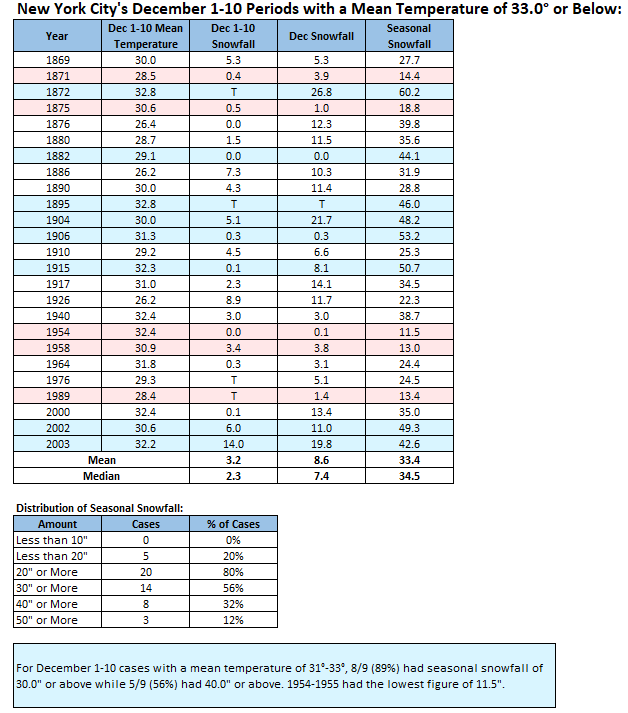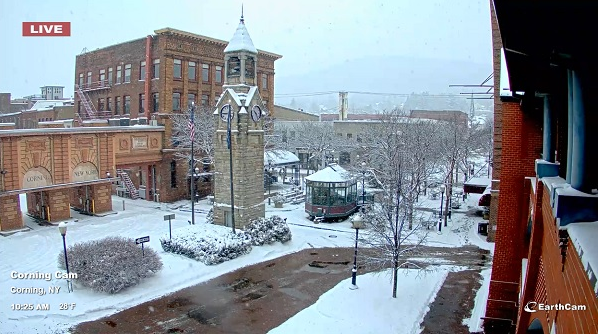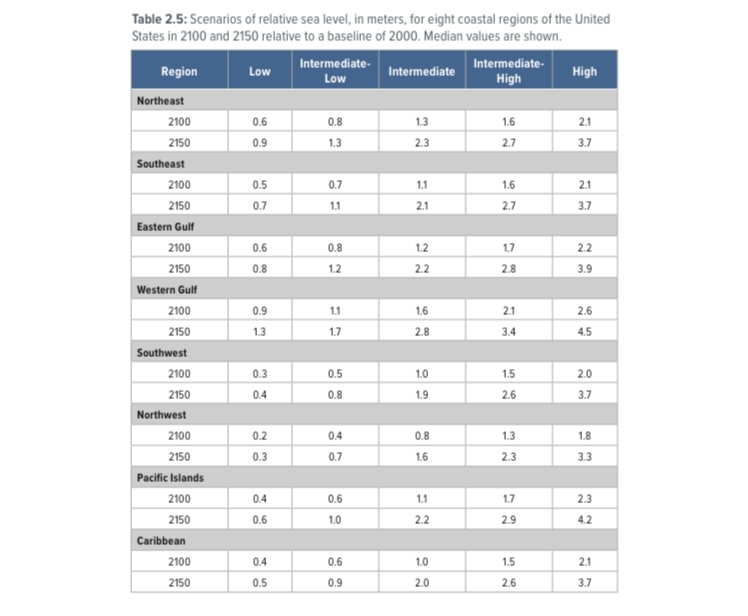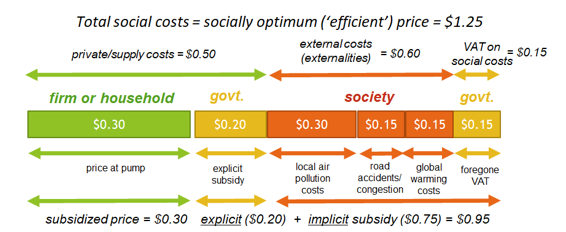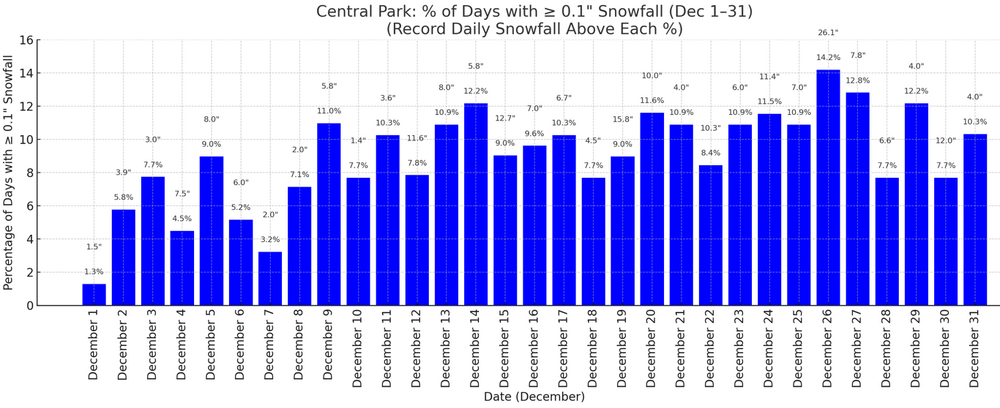-
Posts
22,917 -
Joined
Content Type
Profiles
Blogs
Forums
American Weather
Media Demo
Store
Gallery
Everything posted by donsutherland1
-
612 NOUS41 KOKX 022136 PNSOKX CTZ005>012-NJZ002-004-006-103>108-NYZ067>075-078>081-176>179-030936- Public Information Statement National Weather Service New York NY 436 PM EST Tue Dec 2 2025 ...SNOWFALL REPORTS... Location Amount Time/Date Provider ...Connecticut... ...Fairfield County... 4 NNW New Fairfield 2.5 in 0404 PM 12/02 Trained Spotter ...New York... ...Orange County... 2 SW Middletown 3.9 in 0330 PM 12/02 Fire Dept/Rescue 2 S Montgomery Airport 3.1 in 0301 PM 12/02 Public 1 WNW Monroe 2.5 in 1245 PM 12/02 Trained Spotter 1 NNE Chester 2.3 in 0112 PM 12/02 Trained Spotter Pine Bush 2.2 in 1220 PM 12/02 Public 1 WSW Balmville 2.2 in 0130 PM 12/02 Public 2 E Highland Mills 2.2 in 0157 PM 12/02 Public 2 SSW Middletown 2.0 in 1209 PM 12/02 Trained Spotter 1 NNE Chester 2.0 in 1230 PM 12/02 Trained Spotter 2 SSW Stewart Airport 2.0 in 0144 PM 12/02 Public 3 WNW Warwick 2.0 in 0340 PM 12/02 Public Chester 1.0 in 1056 AM 12/02 Cocorahs ...Westchester County... Peekskill 1.1 in 1200 PM 12/02 Public &&
-
While New York City and its immediate suburbs experienced a cold rain, parts of the region saw some snow. Peekskill picked up 1.1" of snow. 2 SW of Middletown received 3.9". Binghamton saw 5.9". A colder than normal pattern is in place. A prolonged stretch of below normal temperatures will likely continue into or through the second week of December. December 1-10 will be a solidly colder than normal period. The potential exists for the coldest first 10 days of December since at least 2007 (33.4°, 5th coldest December 1-10 since 2000). The five coldest December 1-10 periods since 2000 were: 1. 30.6°, 2002 2. 32.2°, 2003 3. 32.4°, 2000 4. 33.1°, 2005 5. 33.4°, 2007 All 5 of these cases had measurable snowfall in Central Park. Rain will end tonight. Tomorrow will be blustery and cool with highs in the upper 30s and lower 40s. The coldest air mass so far this season will overspread the region starting Thursday or Thursday night. The temperature will tumble into the 20s Thursday night before bottoming out in the lower 20s Friday morning. It now appears that the weekend will be cool but dry. The ENSO Region 1+2 anomaly was -0.1°C and the Region 3.4 anomaly was -0.6°C for the week centered around November 26. For the past six weeks, the ENSO Region 1+2 anomaly has averaged -0.18°C and the ENSO Region 3.4 anomaly has averaged -0.67°C. La Niña conditions will likely continue through at least mid-winter. The SOI was -11.42 today. The preliminary Arctic Oscillation (AO) was +0.016 today.
-
Some fun statistics. Whether things actually wind up like the often snowy winters associated with a very cold start to December remains to be seen.
-

Arctic Sea Ice Extent, Area, and Volume
donsutherland1 replied to ORH_wxman's topic in Climate Change
Overall, Arctic sea ice extent is far below the prior record for December 1st. On December 1, Arctic sea ice extent was 9.342 million square kilometers. That was 419,000 square kilometers below the prior record that had been set in 2016. The 2010s average was 10.450 million square kilometers. The 1980s figure was 12.137 million square kilometers. 2024 and 2025 is the first case where two consecutive years saw less than 10 million square kilometers on December 1. Source: JAXA -
As per mPING, the precipitation has started as rain in New York City and southern Westchester County. North of White Plains, there was a rain/snow mixture.
-
According to NWS data, the 8 am temperature in the Bronx was 36°. Even as there remains a chance that some snow/sleet could be seen at the onset of the precipitation, no accumulation is likely. As per mPING, the precipitation arrived as light rain in Union, NJ. We'll see whether it briefly flips to sleet/snow upon growing heavier. If not, that's not a good sign for the NYC area.
-

Occasional Thoughts on Climate Change
donsutherland1 replied to donsutherland1's topic in Climate Change
We have both discussed it. It’s laughable to think that sea level rise in Miami has zero cost. By 2100, the sea will be 0.7-1.1 meters above its 2000 level (intermediate-low to intermediate scenarios) for the Southeast. By 2150, the numbers are 1.1-2.1 meters. There is no magical solution to avoid the ocean’s reclaiming land at such changes. Source: https://earth.gov/sealevel/us/internal_resources/756/noaa-nos-techrpt01-global-regional-SLR-scenarios-US.pdf -
A colder than normal pattern has now moved into place. A prolonged stretch of below normal temperatures will likely continue into or through the second week of December. December 1-10 will be a solidly colder than normal period. The potential exists for the coldest first days of December since at least 2007 (33.4°, 5th coldest December 1-10 since 2000). The five coldest December 1-10 periods since 2000 were: 1. 30.6°, 2002 2. 32.2°, 2003 3. 32.4°, 2000 4. 33.1°, 2005 5. 33.4°, 2007 All 5 of these cases had measurable snowfall in Central Park. A storm will affect the region on tomorrow into Wednesday, bringing 0.50"-1.50" precipitation to the region. Some wet snowflakes are possible in and around New York City early on, but no accumulation is likely. Interior sections have the highest probability of seeing accumulations of snow. Binghamton and portions of northwest New Jersey will likely see 3"-6" of snow with some locally higher amounts. Albany could see 4"-8" of snow. The coldest air mass so far this season could move into the region late in the week. The temperature will likely tumble into the 20s Thursday night into Friday in New York City. Another system could bring some light precipitation to the region during the weekend. The ENSO Region 1+2 anomaly was -0.1°C and the Region 3.4 anomaly was -0.6°C for the week centered around November 26. For the past six weeks, the ENSO Region 1+2 anomaly has averaged -0.18°C and the ENSO Region 3.4 anomaly has averaged -0.67°C. La Niña conditions will likely continue through at least mid-winter. The SOI was -12.82 today. The preliminary Arctic Oscillation (AO) was +0.520 today.
-

Occasional Thoughts on Climate Change
donsutherland1 replied to donsutherland1's topic in Climate Change
Exactly. They dismiss the simple watt-for-watt comparability of energy sources because they still imagine a world where fossil fuels are the superior source of energy. They rage against any acknowledgment of implicit subsidies, because recognition of those costs reveal how the playing field has been tilted toward fossil fuels for generations. They pretend the economic, environmental, and social costs of engineering a hotter planet are $0, because only that fiction allows them to erase the mounting bill for continuing to choose to burn carbon at a massive scale. A $0 assumption also allows them to set aside the profound ethical choices involved in continuing to reject less expensive and cleaner alternatives for fossil fuels. Trapped in a worldview shaped by the sunk-cost fallacy, they insist that yesterday’s benefits justify tomorrow’s risks. They cling to the comforts of the past as if nostalgia could grant immunity from the consequences for their shortsighted choice. In doing so, they gamble the future on the belief that the benefits of yesterday’s energy can somehow cancel out the costs of the world it is relentlessly warming. -
-

2025-2026 ENSO
donsutherland1 replied to 40/70 Benchmark's topic in Weather Forecasting and Discussion
I suspect other factors are involved. The lag time would be too short to attribute the development to the recent SSWE. -
Personally, I think that there should be a headline. Even if NYC, its nearby suburbs, and Long Island won't be getting much, if any, snowfall, parts of the forum will.
- 362 replies
-
- 11
-

-
-
3"-6" seems realistic for Orange County (as for my sister in Milford, PA). This should be a nice event to get the winter season started.
-

Occasional Thoughts on Climate Change
donsutherland1 replied to donsutherland1's topic in Climate Change
Implicit subsidies are based on imperfect estimates. But they recognize that there are real costs. Those costs are substantial even if they are estimates. One need not agree on the exact figure ($7.1 trillion) to recognize that they are very large. A framework that assumes that such costs don't exist is wholly unrealistic. Also, the IMF's working papers are not scientific in nature. They are estimates for policy makers. Finally, I recognize that there have been subsidies for renewable energy e.g., as one witnessed with the Inflation Reduction Act. An "infant industry" argument can be made. Energy has been a highly subsidized field. One finds a range of tax deductions, credits, and subsidies i.e., a deduction for intangible drilling costs, depletion allowances, accelerated depreciation for oil and gas infrastructure, etc. Unlike some of the renewable technologies, the fossil fuel industry is anything but an infant industry. -

Occasional Thoughts on Climate Change
donsutherland1 replied to donsutherland1's topic in Climate Change
Without doubt, fossil fuel interests and their allies reject the concept of implicit subsidies. Even as implicit subsidies are estimates, they are premised on the reality that that the burning of fossil fuels leads to an increase in particulate matter, dumps greenhouse gases into the atmosphere, and drives changes in climate that have significant societal costs and even larger long-term costs associated with lost economic output, human health, climate change-enhanced disasters, etc. The question isn't whether such costs exist. They do. It isn't whether they are significant. They are. The only meaningful question concerns the exact magnitude of such costs. Estimating implicit subsidies is a far more realistic practice than relying exclusively on an explicit subsidies-only framework. An explicit subsidies-only framework rests on the fatally-flawed assumption that there are no costs from the burning of fossil fuels beyond those captured in explicit subsidies. Implicit subsidies provide a fuller and much more realistic picture. It's obviously a picture the fossil fuel interests seek to mask, much as the tobacco interests had done in the face of rising lung cancer cases and other smoking-related conditions decades earlier. It is also no less unethical than the deceptive practices deployed by the embattled tobacco industry at that time. Fossil fuel interests, who are largely responsible for the problem of anthropogenic climate change, want to dictate the rules by which society views energy in general and costs of energy in particular. They don't want society to accept that there are better, cleaner, less costly alternatives for a growing share of energy needs. The International Monetary Fund chooses to provide a fuller picture. It isn't perfect, but it is far more complete than one the fossil fuel interests seek to paint.The IMF's framework is far more accurate than any simplistic framework that treats the implicit subsidies associated with the burning of fossil fuels as $0. -
A cooler than normal November is concluding. New York City is finishing with a monthly mean temperature of 47.2°, which is 0.8° below normal (0.5° below the older 1981-2010 baseline). A cold front will bring showers tonight into early tomorrow. Afterward, a prolonged stretch of below normal temperatures will likely continue into or through the second week of December. December 1-10 will be a solidly colder than normal period. The potential exists for the coldest first days of December since at least 2010 (34.6°, 6th coldest December 1-10 since 2000). The five coldest December 1-10 periods since 2000 were: 1. 30.6°, 2002 2. 32.2°, 2003 3. 32.4°, 2000 4. 33.1°, 2005 5. 33.4°, 2007 All 5 of these cases had measurable snowfall in Central Park. A storm will affect the region on Tuesday into Wednesday, bringing 0.50"-1.50" precipitation to the region. There is a distinct possibility that New York City could see its first measurable snowfall of the season, even as the storm will be mainly a rain event. Interior sections have the highest probability of seeing accumulations of snow. The coldest air mass so far this season could move into the region late in the week. The temperature will likely tumble into the 20s Thursday night into Friday in New York City. Another system could bring some light precipitation to the region during the weekend. The ENSO Region 1+2 anomaly was -0.7°C and the Region 3.4 anomaly was -0.7°C for the week centered around November 12. For the past six weeks, the ENSO Region 1+2 anomaly has averaged -0.16°C and the ENSO Region 3.4 anomaly has averaged -0.65°C. La Niña conditions will likely continue through at least mid-winter. The SOI was -2.04 today. The preliminary Arctic Oscillation (AO) was -0.064 today.
-

Occasional Thoughts on Climate Change
donsutherland1 replied to donsutherland1's topic in Climate Change
For perspective, no industry comes close to the explicit and implicit subsidies received by the fossil fuel industry. From the IMF: -

E PA/NJ/DE Winter 2025-26 Obs/Discussion
donsutherland1 replied to LVblizzard's topic in Philadelphia Region
Some December Snowfall Statistics: For Philadelphia, the December date(s) with the highest frequency of each snowfall threshold is: Measurable snowfall: December 14 and December 29: 15 occurrences 1.0" or more snow: December 5 and December 26: 10 occurrences 6.0" or more snow: December 19 and December 26: 3 occurrences 10.0" or more snow: December 26: 2 occurrences -

2025-2026 ENSO
donsutherland1 replied to 40/70 Benchmark's topic in Weather Forecasting and Discussion
The 11/30 0z and 6z GEFS has returned to a warmer outlook for much of North America after December 10th. It offers a credible alternative scenario. I'm still going with the EPS/ECMWF weeklies, as the GEFS has shown inconsistency. Moreover, the size of the rebound in temperatures (December 11-20 vs. December 1-10) would be both extreme and rare. Nevertheless, a look at the alternative scenario is still in order as a muted variation is plausible. The GEFS's development of a fairly strong PNA- is the key variable differentiating it from the colder baseline idea shown on the EPS. The latest two cycles of the GEFS show the development of a WPO-/EPO+/AO-/PNA- pattern. The GEFS maps are consistent with the largest cluster for the December 5-15 period (39%) of cases. WPO-/EPO+/AO-/PNA- Maps (Largest December 5-15 cluster): 500 mb Height Anomalies: Temperature Anomalies: GEFS (11/30 6z cycle): Days 11-15: 500 mb Height Anomalies (5-day average): Temperature anomalies (5-day average): -
Central Park's frequency of measurable snowfall in December and record daily snowfall. December 26 is New York City's snowiest December date. Frequency of select daily snowfall amounts (1869-2024): Measurable snowfall: 22 times 1" or more: 16 times 6" or more: 5 times 10" or more: 5 times
-

Nov 28-30th Post Turkey Day Winter Storm
donsutherland1 replied to Chicago Storm's topic in Lakes/Ohio Valley
-
So far, 5"-7" of snow has fallen in the greater Chicago area. Daily snowfall records for November 29th have fallen in both Rockford and Chicago. The snowstorm will continue to blanket parts of the Great Lakes Region tonight into early tomorrow. Chicago and Milwaukee will likey see 6"-12" of snow. Some locally higher amounts are possible. Detroit could pick up 4"-8". Toronto could see 3"-6". In the New York City area, tomorrow and Monday will be somewhat milder. Showers are possible on Monday as a cold front moves across the region. Generally colder than normal conditions could then continue into or through the second week of December. Severe cold appears unlikely through at least the first 10 days of December. Nevertheless, December 1-10 will be a solidly colder than normal period. Moreover, a storm could affect the region on Tuesday into Wednesday, bringing 0.50"-1.50" precipitation to the region. There is a distinct possibility that New York City could see its first measurable snowfall of the season. Interior sections have the highest probability of seeing accumulations of snow. The ENSO Region 1+2 anomaly was -0.7°C and the Region 3.4 anomaly was -0.7°C for the week centered around November 12. For the past six weeks, the ENSO Region 1+2 anomaly has averaged -0.16°C and the ENSO Region 3.4 anomaly has averaged -0.65°C. La Niña conditions will likely continue through at least mid-winter. The SOI was -3.95 today. The preliminary Arctic Oscillation (AO) was -0.264 today. Based on sensitivity analysis applied to the latest guidance, there is an implied near 100% probability that New York City will have a cooler than normal November (1991-2020 normal). November will likely finish with a mean temperature near 47.2° (0.8° below normal). Supplemental Information: The projected mean would be 0.5° below the 1981-2010 normal monthly value.


